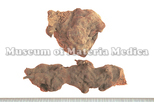Smilax Rhizome

|
TMPW No.:1210 |
| Synonym | |
| Latin name | Smilacis Rhizoma |
| Botanical source: Family name | Liliaceae |
| Botanical source: Plant name | Smilax glabra Roxburgh (IPNI:541462-1) |
| Part used | Rhizome |
| Empirical criteria for quality selection | The outer surface of Good one is pale reddish brown in color. The inside is powder-like white. The one which has rotten or blighted parts is not good. (TN) |
| Constituents | Polysaccharides: Starch Steroid saponins & Sapogenins: Smilax china: Smilax-saponin A, Smilax-saponin B, Smilax-saponin C Phenylpropanoids: S. glabra: 5-0-caffeoylshikimic acid Chromones: S. glabra: Eurryphin Flavanones & Dihydroflavonols: S. china: Astilbin, Distylin, Engeliten (=Engelitin); S. glabra: Smitilbin, Engeletin, Astilbin, Dihydroquercetin |
| Pharmacological effects | Antiinflammation, antisyphilic, anticarcinogenesis (extract, resveratrol), suppression of autoimmune hepatopathy (eurryphin, resveratrol, smitilbin, eugeletin, astilbin). |
| Indications | As an antidote, for removing dampness by diuresis and heat-clearing drug and eliminating syphilis, Tufuling is applied for chronic skin disease, dermatitis and contracture of limbs and muscle pain in syphilis or mercury poisoning. It is used as a supplementary drug for acute hepatitis. |
| Diseases | Syphilis, Pyogenic dermatosis, Eczema, Psoriasis, Swelling and pain of joint |
| Formulas | hachimitaikaho |
| Meridian tropism | Liver, Stomach |
| Property | Neutral |
| Flavor | Sweet & bland |
| Classification in "Shen-non Ben-cao Jing" | |
| TCM: Classification | Febrifungal and detoxicant drugs |
| TCM: Medicinal effects | To remove damp, to counteract toxicity, and to improve the mobility of joints.: For dysuria with turbid discharge, morbid leukorrhea, carbuncles, lymphadenitis, chronic eczema, contracture of limbs and muscle pain in syphilis with mercury poisoning. |
| Remarks | Listed in the Japanese Pharmacopoeia 18th ed. |
| References | TN: T. Namba & Y. Tsuda ed., Outline of Pharmacognosy, a Textbook, 3rd ed., Nankodo Co., Ltd., Tokyo, 1998. |
